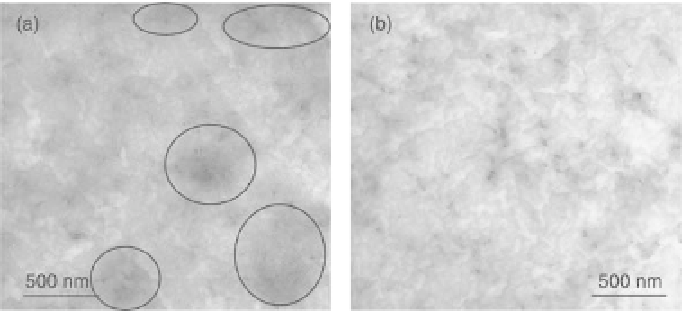Biomedical Engineering Reference
In-Depth Information
14.16 TEM images of PCL nanocomposites filled with (a) 3wt% CNTs
and (b) 3wt% CNT-g-PCL nanohybrids. CNTs remain agglomerated
(black circles) in the CNTs-filled PCL nanocomposites while very small
bundles are observed (circled) when PCL is filled with CNT-g-PCL
nanohybrids (Ruelle, 2009).
nanocomposite, corresponding to a theoretical value for optimal dispersion
of CNTs, which is equal to the inverse of CNT aspect ratio.
The different nanofillers (CNTs, amino-CNTs and CNT-g-PCL nanohy-
brids) were also dispersed in a high-density polyethylene (HDPE) matrix.
TEM analysis indicated that CNTs and amino-CNTs were poorly dispersed
in HDPE while CNT-g-PCL were more homogeneously dispersed, even
though PCL and HDPE are known to be non-miscible polymers. Electrical
measurements confirmed these observations, showing an electrical percola-
tion threshold of 2.5 wt% for CNTs and amino-CNT-filled HDPE
nanocomposites and 1.1 wt% for
samples filled with a CNT-g-PCL
nanohybrid.
The grafting of primary amine groups on the CNT surface did not
influence the dispersion ability of CNTs in PCL and HDPE matrices.
However, the electrical measurements showed that the electrical conductiv-
ity of amino-CNTs was higher than that of pristine CNTs; functionalization
can be used to improve the electrical conductivity. This last result confirmed
that the CNT structure is preserved after CNT functionalization in the
microwave plasma post-discharge.
14.4 Summary
Offering both a high aspect ratio (length-to-diameter) and a low density,
CNTs show strong application potential as advanced filler materials to
replace or complement the conventional nanofillers, such as nanoclays, in
the fabrication of multifunctional polymer nanocomposites. In this field, the
degree of dispersion of the individual CNTs is an essential parameter to
produce nanocomposite materials with enhanced properties. In order to

